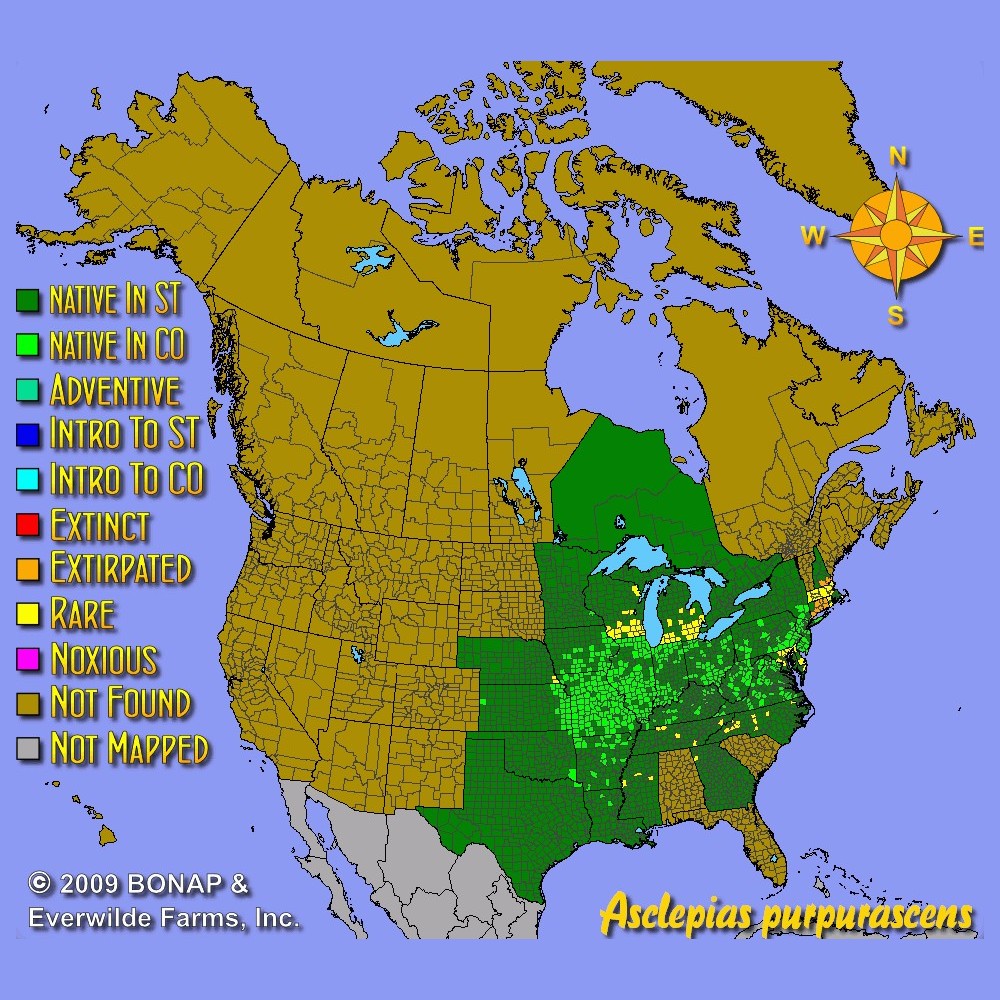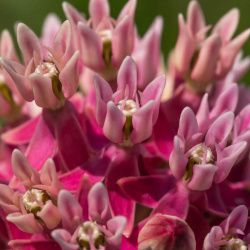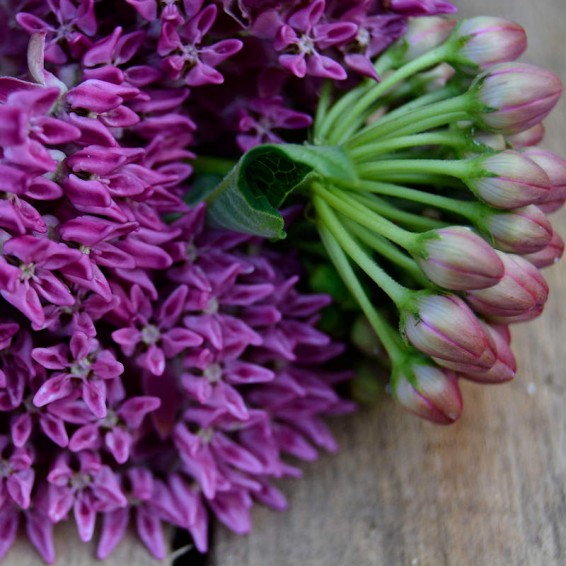Purple Milkweed Seeds
- HOW TO GROW
- FAST FACTS
- REVIEWS
HOW TO GROW
Sowing: In late fall, direct sow just below the surface. Germination will take place in the spring, after the last frost. When the seedlings appear, thin to the strongest plant; seedlings usually do not survive transplanting, since they resent any disturbance of their roots. For spring planting, mix the Asclepias Purpurascens seeds with moist sand and refrigerate for 30 days before direct sowing.
Growing: Young plants should be watered until they become established; when grown from seed, plants may take up to three years to produce flowers. Mature plants can tolerate some drought but grow best with regular watering, especially if grown in full sun. Though not invasive, this plant will eventually spread by rhizomes and forms colonies in the wild. The flowers attract many bees and butterflies, including swallowtails, red admirals, an hairstreaks. Deer avoid this plant.
Harvesting: This makes a striking cut flower. Cut the stems long, choosing flowers that have just opened. Keep in mind that the milky sap is mildly toxic and can irritate the skin.
Seed Saving: After the plant finishes flowering, 3-4" narrow pods will form. Be sure to harvest the pods before they split and the silky fluff carries the seeds away on the wind. As soon as the Asclepias Purpurascens seeds inside the pod ripen to their mature brown color, remove the pods and spread them out to dry. Split open the pods and take out the silky seed material. Remove the fluff from the seeds. Store the purple milkweed seeds in a cool, dry place.
FAST FACTS
Latin Name: Asclepias purpurascens
Species Origin: US Native Wildflower
Type: Native Wildflowers
Life Cycle: Perennial
USDA Zones: 4, 5, 6, 7, 8
US Regions: Midwest, Northeast, Southeast
Seeds per Ounce: 5,300
Stratification: Cold/Wet for 4 Weeks
Germination Ease: Stratify 4 Weeks
Sunlight: Full Sun, Part Sun
Height: 30 Inches
Color: Pink
Bloom Season: Blooms Late Summer
Uses: Attracts Pollinators, Attracts Honeybees, Attracts Butterflies, Hummingbirds, Deer Resistant
Disappointed, to be honest
I recently ordered several packets of purple milkweed seeds. I was disappointed to open the packets and find mostly small, light-colored and broken seeds. A few seeds look okay but most look like they were harvested before the seed pod matured. Time will tell if they are viable or not. I have been planting milkweed for several years now so I do know how seeds should look. The good news is that Everwilde has offered to either refund or replace and I give them credit for that.
Hello! Sorry you received some crushed seeds and some substandard ones. We have reshipped these seeds!
Great seeds in great packet!
I really appreciate the new seed packs. Great info about planting needs, height, etc. They are also very pretty to look at. I think I probably love flowers because I love color and these packets are so nice. Price was very reasonable, delivery was quick, and the seeds were nice and healthy looking. I planted them almost as soon as I got them in the mail. I've always had very good luck with getting Everwilde seeds to germinate and grow and feel certain these will soon sprout.
DESCRIPTION

HOW TO GROW
Sowing: In late fall, direct sow just below the surface. Germination will take place in the spring, after the last frost. When the seedlings appear, thin to the strongest plant; seedlings usually do not survive transplanting, since they resent any disturbance of their roots. For spring planting, mix the Asclepias Purpurascens seeds with moist sand and refrigerate for 30 days before direct sowing.
Growing: Young plants should be watered until they become established; when grown from seed, plants may take up to three years to produce flowers. Mature plants can tolerate some drought but grow best with regular watering, especially if grown in full sun. Though not invasive, this plant will eventually spread by rhizomes and forms colonies in the wild. The flowers attract many bees and butterflies, including swallowtails, red admirals, an hairstreaks. Deer avoid this plant.
Harvesting: This makes a striking cut flower. Cut the stems long, choosing flowers that have just opened. Keep in mind that the milky sap is mildly toxic and can irritate the skin.
Seed Saving: After the plant finishes flowering, 3-4" narrow pods will form. Be sure to harvest the pods before they split and the silky fluff carries the seeds away on the wind. As soon as the Asclepias Purpurascens seeds inside the pod ripen to their mature brown color, remove the pods and spread them out to dry. Split open the pods and take out the silky seed material. Remove the fluff from the seeds. Store the purple milkweed seeds in a cool, dry place.
FAST FACTS
Latin Name: Asclepias purpurascens
Species Origin: US Native Wildflower
Type: Native Wildflowers
Life Cycle: Perennial
USDA Zones: 4, 5, 6, 7, 8
US Regions: Midwest, Northeast, Southeast
Seeds per Ounce: 5,300
Stratification: Cold/Wet for 4 Weeks
Germination Ease: Stratify 4 Weeks
Sunlight: Full Sun, Part Sun
Height: 30 Inches
Color: Pink
Bloom Season: Blooms Late Summer
Uses: Attracts Pollinators, Attracts Honeybees, Attracts Butterflies, Hummingbirds, Deer Resistant
Reviews
Review
Disappointed, to be honest
I recently ordered several packets of purple milkweed seeds. I was disappointed to open the packets and find mostly small, light-colored and broken seeds. A few seeds look okay but most look like they were harvested before the seed pod matured. Time will tell if they are viable or not. I have been planting milkweed for several years now so I do know how seeds should look. The good news is that Everwilde has offered to either refund or replace and I give them credit for that.
Hello! Sorry you received some crushed seeds and some substandard ones. We have reshipped these seeds!
Review
Great seeds in great packet!
I really appreciate the new seed packs. Great info about planting needs, height, etc. They are also very pretty to look at. I think I probably love flowers because I love color and these packets are so nice. Price was very reasonable, delivery was quick, and the seeds were nice and healthy looking. I planted them almost as soon as I got them in the mail. I've always had very good luck with getting Everwilde seeds to germinate and grow and feel certain these will soon sprout.
Also Consider These:
-
 Out Of Stock
Red Milkweed Seeds
Asclepias rubra
Attractive to both hummingbirds and butterflies, this variety makes an excellent choice for wetland gardens. The fragrant flowers grow to a medium height, so makes a great specimen plant as well. This wildflower is a rare type of milkweed and is often not available.Quick Viewx
Out Of Stock
Red Milkweed Seeds
Asclepias rubra
Attractive to both hummingbirds and butterflies, this variety makes an excellent choice for wetland gardens. The fragrant flowers grow to a medium height, so makes a great specimen plant as well. This wildflower is a rare type of milkweed and is often not available.Quick ViewxRed Milkweed Seeds
Asclepias rubra
Attractive to both hummingbirds and butterflies, this variety makes an excellent choice for wetland gardens. The fragrant flowers grow to a medium height, so makes a great specimen plant as well. This wildflower is a rare type of milkweed and is often not available.
$3.96 Pkt - $136.00 / Oz








